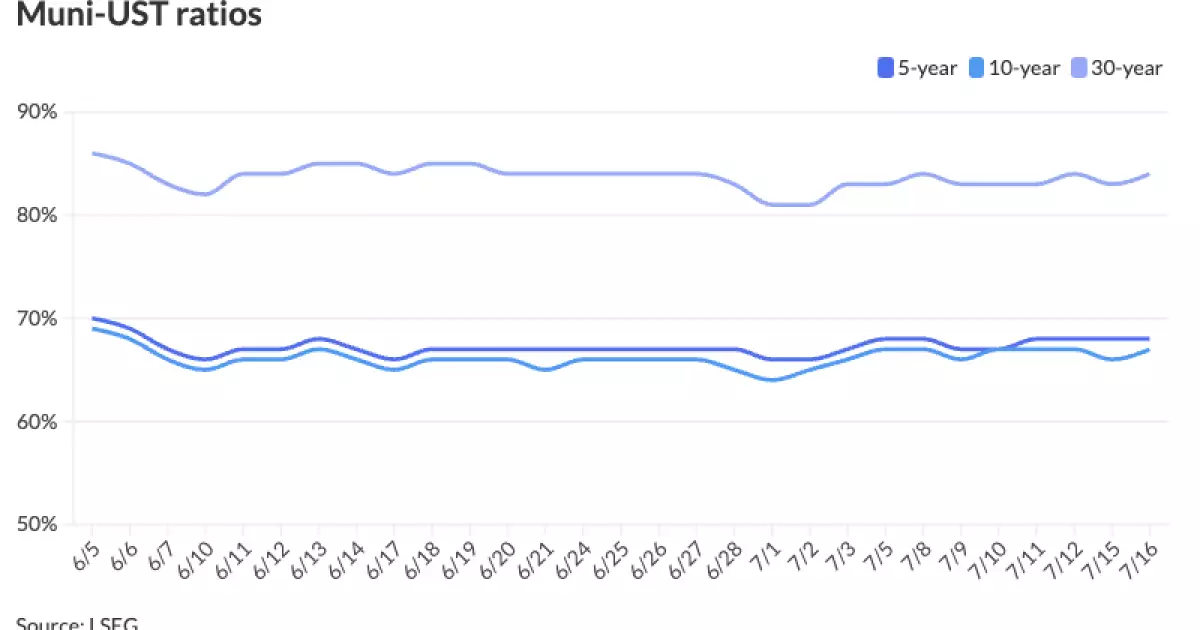The municipal bond market has recently exhibited a positive uptick, as indicated by firmer secondary trading on Tuesday. This momentum coincides with an uptick in the primary market, where fresh issues are attracting investor interest. A noteworthy decline in U.S. Treasury yields further augments this development, combining to create a favorable environment for municipal bonds. Refinitiv Municipal Market Data’s report at 3 p.m. EST illustrated varying ratios between municipal bonds and Treasuries, highlighting a robust engagement in this segment. Specifically, the two-year muni-to-Treasury ratio stood at 65%, with other maturities like five-year and 10-year bonds trailing closely behind. These figures are crucial as they reflect investor sentiment and the relative attractiveness of municipal securities compared to Treasuries.
Market analysts are increasingly optimistic about the conditions that are fostering this rally in municipal bonds. Matt Fabian from Municipal Market Analytics highlighted the impact of the June consumer price index report, which has considerably raised hopes for a Federal Reserve rate cut in September. However, he cautions that shorter maturities may be “overbought” and should be approached cautiously. This perspective indicates a bifurcation within the curve, where the shorter end becomes less appealing compared to the rest of the maturity spectrum, which remains oversold. Hence, investors could perceive this as a strategic opportunity to capitalize on better potential returns in the near term.
Meanwhile, as about $40 billion in tax-exempt reinvestment approaches in August—the largest anticipated month for 2024—retail investors are encouraged to redeploy their principal back into municipals. The last week’s tradings also reflected substantial engagement, with considerable activity in separately managed accounts (SMAs). This level of engagement indicates a growing bullish sentiment among retail investors and could pave the way for sustained demand in the municipal bond market.
Inconsistent Fund Flows, Yet Promising Opportunities
A closer examination of mutual fund flows reveals a mixed picture. While inflows have been inconsistent, there are signs that exchange-traded funds (ETFs) have garnered attention. This could reflect a broader investor strategy where cash is being kept at the ready in anticipation of a favorable tax-exempt allocation. The stabilization of fund flows, coupled with growing dealer inventories over the summer, suggests that market participants are preparing for a more dynamic trading environment in the coming months.
The current issuance is projected to reach approximately $10.7 billion this week alone, underpinning the robust market activity. Notable recent transactions include Miami-Dade County’s significant issuance of aviation revenue refunding bonds, highlighting institutional demand for high-quality municipal securities. The terms provided, such as the callable structure and varying yields across different maturities, showcase the intricate financial engineering involved in these transactions, thus providing investors with a spectrum of choices based on their investment objectives.
Fabian’s insights suggest that the anticipated rise in supply may not necessarily be detrimental to market performance. Instead, if combined with positive fund flows, the municipal bond sector may continue to thrive. The issuances set for the near future, including significant offerings from entities like the New York City Transitional Finance Authority and the Regents of the University of California, further emphasize the sustained interest in the municipal bond space. The bids on these offerings will likely reveal much about investor confidence and market appetite moving forward.
As the yield landscape evolves, it is essential for investors to remain vigilant. The AAA municipal yield curve adjustments seen in expectations also indicate adaptive market behavior as traders respond to changing conditions. It’s noteworthy that U.S. Treasury yields have also shown declines on various maturities, propagating a broader scope of investment allure.
The current trends in the municipal bond market underscore a potentially favorable outlook driven by various economic factors, including Federal Reserve anticipations and reinvestment opportunities. As issuance ramps up and market dynamics continue to shift, both retail and institutional investors must carefully evaluate their strategies to maximize returns. The nuance between maturities presents both challenges and opportunities, demanding a well-informed approach. Consequently, recent developments suggest that the municipal bond market remains a crucial component of many investors’ portfolios, with possibilities for growth even amidst the unpredictabilities inherent in financial markets.

